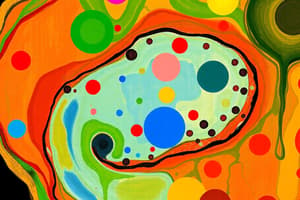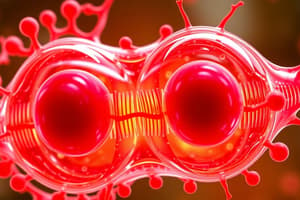Podcast
Questions and Answers
What is the primary role of the plasma membrane in a cell?
What is the primary role of the plasma membrane in a cell?
- To act as a selectively permeable barrier. (correct)
- To control cellular activities within the nucleus.
- To directly interact with the cytoplasm.
- To house organelles that perform specific cell functions.
Which of the following is an example of a non-membrane-bound organelle?
Which of the following is an example of a non-membrane-bound organelle?
- Golgi apparatus
- Ribosome (correct)
- Mitochondria
- Lysosome
According to the fluid mosaic model, what contributes to the fluidity of the plasma membrane?
According to the fluid mosaic model, what contributes to the fluidity of the plasma membrane?
- The absence of cholesterol
- The static arrangement of phospholipids
- The rigid arrangement of proteins
- The mosaic arrangement of phospholipids, carbohydrates, proteins, and cholesterol (correct)
What property of phospholipids causes them to arrange into a bilayer in an aqueous environment?
What property of phospholipids causes them to arrange into a bilayer in an aqueous environment?
What is the function of cholesterol within the plasma membrane?
What is the function of cholesterol within the plasma membrane?
What characteristic is common to all integral proteins?
What characteristic is common to all integral proteins?
How do transmembrane proteins facilitate the transport of water-soluble molecules across the plasma membrane?
How do transmembrane proteins facilitate the transport of water-soluble molecules across the plasma membrane?
What is the role of membrane receptors in signal transduction?
What is the role of membrane receptors in signal transduction?
Where are carbohydrates typically found in the plasma membrane?
Where are carbohydrates typically found in the plasma membrane?
What is the glycocalyx primarily composed of?
What is the glycocalyx primarily composed of?
What determines whether a molecule can pass through the plasma membrane by simple diffusion?
What determines whether a molecule can pass through the plasma membrane by simple diffusion?
In carrier-mediated facilitated diffusion, what causes the carrier protein to release the transported substance on the other side of the membrane?
In carrier-mediated facilitated diffusion, what causes the carrier protein to release the transported substance on the other side of the membrane?
What is the primary difference between channel-mediated and carrier-mediated facilitated diffusion?
What is the primary difference between channel-mediated and carrier-mediated facilitated diffusion?
What is the role of aquaporins in osmosis?
What is the role of aquaporins in osmosis?
What is the effect of placing a cell in a hypertonic solution?
What is the effect of placing a cell in a hypertonic solution?
How does primary active transport differ from facilitated diffusion?
How does primary active transport differ from facilitated diffusion?
What is the function of the sodium-potassium pump?
What is the function of the sodium-potassium pump?
In secondary active transport, what provides the energy to move a substance against its concentration gradient?
In secondary active transport, what provides the energy to move a substance against its concentration gradient?
What is transcytosis?
What is transcytosis?
What is the initial step in endocytosis?
What is the initial step in endocytosis?
What name is given to this model of membrane structure?
What name is given to this model of membrane structure?
What is the function of cholesterol molecules in the plasma membrane?
What is the function of cholesterol molecules in the plasma membrane?
Name the carbohydrate-rich area at the cell surface that aids in binding cells together.
Name the carbohydrate-rich area at the cell surface that aids in binding cells together.
The hydrophobic region of the plasma membrane is polar.
The hydrophobic region of the plasma membrane is polar.
What protein acts as a "stiffener" in microvilli?
What protein acts as a "stiffener" in microvilli?
Which of the following substances move passively through the lipid part of the membrane by simple diffusion?
Which of the following substances move passively through the lipid part of the membrane by simple diffusion?
Which of the following substances enter the cell by attachment to a passive-transport protein carrier?
Which of the following substances enter the cell by attachment to a passive-transport protein carrier?
Which substances pass through channel-mediated (pores) by facilitated diffusion?
Which substances pass through channel-mediated (pores) by facilitated diffusion?
Which substances pass through the plasma membrane by way of sodium-potassium pump proteins?
Which substances pass through the plasma membrane by way of sodium-potassium pump proteins?
Match the following transport mechanisms with their descriptions
Match the following transport mechanisms with their descriptions
Flashcards
Plasma membrane
Plasma membrane
The outer boundary of a cell, acting as a selectively permeable barrier.
Cytoplasm
Cytoplasm
The intracellular fluid packed with organelles, performing specific cell functions.
Nucleus
Nucleus
An organelle that controls cellular activities, often near the cell's center.
Membrane-bound organelles
Membrane-bound organelles
Signup and view all the flashcards
Non-membrane-bound organelles
Non-membrane-bound organelles
Signup and view all the flashcards
Fluid mosaic model
Fluid mosaic model
Signup and view all the flashcards
Phospholipids
Phospholipids
Signup and view all the flashcards
Cholesterol
Cholesterol
Signup and view all the flashcards
Integral membrane proteins
Integral membrane proteins
Signup and view all the flashcards
Peripheral membrane proteins
Peripheral membrane proteins
Signup and view all the flashcards
Carbohydrates (in membrane)
Carbohydrates (in membrane)
Signup and view all the flashcards
Diffusion
Diffusion
Signup and view all the flashcards
Simple diffusion
Simple diffusion
Signup and view all the flashcards
Facilitated diffusion
Facilitated diffusion
Signup and view all the flashcards
Osmosis
Osmosis
Signup and view all the flashcards
Hydrostatic pressure
Hydrostatic pressure
Signup and view all the flashcards
Osmotic pressure
Osmotic pressure
Signup and view all the flashcards
Isotonic solutions
Isotonic solutions
Signup and view all the flashcards
Active transport
Active transport
Signup and view all the flashcards
Primary active transport
Primary active transport
Signup and view all the flashcards
Study Notes
Cell Structure
- Cells possess three key structural components: the plasma membrane, cytoplasm, and nucleus.
- The plasma membrane acts as an outer boundary.
- The cytoplasm is the intracellular fluid containing varied organelles.
- The nucleus governs cellular activities and is often located near the cell's center.
Membrane-Bound vs. Non-Membrane Bound Organelles
- Membrane-bound organelles are enclosed by a phospholipid bilayer that separates their inner fluid from the cytoplasm.
- These include the nucleus, Golgi apparatus, RER, SER, mitochondria, lysosomes, and peroxisomes.
- Non-membrane-bound organelles interact directly with the cytoplasm without a surrounding layer.
- examples of these are centrioles, cytoskeleton, and ribosomes.
Plasma Membrane Structure
- The fluid mosaic model explains the plasma membrane's structure.
- It describes the plasma membrane as a dynamic assembly of phospholipids, carbohydrates, proteins, and cholesterol.
Lipid Components
- Phospholipids form a bilayer in the plasma membrane.
- Each phospholipid features a polar hydrophilic head and a nonpolar hydrophobic tail.
- The tails face inward, encouraging self-assembly and resealing.
- Cholesterol constitutes 20% of membrane lipids, with both polar and nonpolar regions.
- Cholesterol stiffens the membrane by wedging between phospholipid tails.
Protein Components
- Integral proteins are integrated into the phospholipid bilayer, often spanning its entire width as transmembrane proteins.
- They contain both hydrophobic and hydrophilic regions for interaction within the membrane
- Some transmembrane proteins transport water-soluble molecules or ions through pores, bypassing the lipid layer.
- Other integral proteins act as carriers or receptors for signal transduction.
- Peripheral proteins attach loosely to integral proteins, or anchor via hydrophobic regions, on the cytoplasmic side.
- Functions include enzymatic activity, motor functions, and linking cells.
Carbohydrate Components
- Carbohydrates attach to the membrane's extracellular surface, binding to proteins and lipids.
- Glycolipids have two fatty acid tails, but a carbohydrate replaces the phosphate head.
- Glycoproteins & Glycolipids form a glycocalyx ("sugar coat") that is enriched by secreted glycoproteins.
Membrane Transport: Diffusion
- Diffusion involves molecules moving from areas of higher to lower concentration, down a concentration gradient.
- Substances that use simple diffusion can pass directly through the lipid bilayer.
- This group includes small, nonpolar, lipid-soluble molecules like O2, CO2, steroid hormones, & fatty acids.
- Molecule size and lipid solubility determines the passibility by simple diffusion
Facilitated Diffusion
- Necessary for glucose, certain sugars, amino acids, and ions.
- It involves carrier proteins or water-filled channel proteins for passive transport across the membrane.
- carrier mediated, relies on transmembrane proteins specifically for large or polar molecules
- Channels are trans membrane proteins that typically transport ions and water with pore sizes that determine entry.
- Leakage channels are commonly open, but gated channels require chemical or electrical signals to pass through.
- Oxygen, water, glucose, and diverse ions perform essential roles, with their passive diffusion acting as an energy-saving mechanism.
Osmosis
- It occurs when water moves through a selectively permeable membrane from high to low water concentration.
- Water diffuses through due to its size and via aquaporins (AQPs).
- No net osmosis occurs with equal water or solute concentrations.
- The extent of water concentration depends on the number of solute particles present.
Osmotic/Hydrostatic Pressure, Tonicity
- Osmolarity refers to the total concentration of solute particles in a solution
- Hydrostatic pressure pushes fluid, while Osmotic pressure pulls it back in.
- Tonicity is the ability of a solution to alter cell shape by changing its internal water volume.
- Isotonic solutions maintain a cell's normal shape, whereas hypertonic solutions cause cells to shrink, and hypotonic solutions cause cells to swell or burst.
- Osmolarity is based on total solute concentration, while tonicity depends on both solute concentration and membrane permeability.
Active Transport
- Active transport uses transport proteins to move substances against their concentration gradients and NEEDS energy.
- Facilitated diffusion ALWAYS follows concentration gradients due to kinetic energy
- Primary active transport uses ATP hydrolysis to power transport proteins called pumps.
- An example is the sodium-potassium pump.
- Pumps 3 Na+ outside the cell and 2 K+ inside with each ATP molecule.
- This helps maintain normal fluids in the cell.
- Electrochemical gradients influence ion diffusion due to the charged faces of the membrane.
Secondary Active Transport
- It uses stored energy from ionic concentration gradients to move an additional substance using a cotransport protein.
- Movement of one solute down concentration gradients is coupled to the movement of another substance up its gradient.
- An example is the Na+-K+ pump, cotransporting sugars, amino acids, and various ions into small intestine cells.
- A symport system moves substances in the same direction.
- An antiport system moves them in opposite directions.
Vesicular Transport
- Transports fluids with large particles and macromolecules by using vesicles in the cell
- Like active transport, this method moves larger particles into (endocytosis) and out of cells (exocytosis)
- This process needs to also power Transcytosis and Vesicular trafficking
- Transcytosis moves substances across a cell
- Vesicular Trafficking moves them within a a cell or organelle
- This transport requires energy from ATP and sometimes GTP to move throughout the cell
Endocytosis
- It moves substances into the cell using receptors that help determine molecule pathways
- The process begins with a coated pit that infolds the membrane and deforms it with protein coating
- 3 types determine action and type of material being taking in
- Phagocytosis engulfs larger material by surrounding extensions to form a phagosome
- uses macrophages and WBCs called Phagocytes
- Pinocytosis (fluid-phase endocytosis) gathers a set amount of extracellular fluid with sorting -This is a routine action
- Receptor Mediated gathers specific molecules via a selective mechanisms
- This is the main method for cells to collect macromolecules and use the assistance of fluids like Insulin
- Phagocytosis engulfs larger material by surrounding extensions to form a phagosome
- Viruses and toxins can enter a cell using this approach too
Exocytosis
- It moves molecules from the inside to out, of the cell, which starts when hormones bing to surface signals
- Common in waste ejection, hormone secretion and neurotransmitter release
- Molecules are enclosed a secretory vesicle to be transported to the plasma membrane
- v-SNARES and t-SNARES proteins guide the action as well
Membrane Junctions
- Gap Junctions are communicating with very close linings that bind to hollow cylinders of transmembrane proteins called connexons to determine what can pass through from cell to cell
- Tight Junctions bond in a ziplock style and form an impermeable separation
- Desmosomes do not fully connect but rivet the space and reduce separation, and can result in skin blistering
DNA as the Control Center
- RNA molecules are not always made from DNA
- DNA contains genetic information in nucleotide base sequences
- A gene is a segment of molecules within DNA that determines polypeptide chains
- The four nucleotide bases are letters that code and define the arrangement of amino acids
- Triplets form the sentence
- Our genes made up sequences, code for protein, which use parts called Exons and Introns
- RNA is required to not only decode, but also carry messaging like a player of music
- The code is formed by messenger (mRNA), which allows synthesis of proteins
- Ribosomes form the base material for protein synthesis to occur
- Transfer material (tRNA) aids in the messaging needed for protein structure
- The role is to not just synthesize and transport through a cell but aid the short lived messages needed
Gene Activation and mRNA Processing
- Before beginning, activating messengers, called transcription factors are necessary to stimulate the histones (proteins in the nucleosome) at the gene transcription site
- The transcription factors bind to the promoter and decide what DNA strand goes to template
- RNA polymerase catalyzed the synthesis of mRNA to start the intiation phase
- mRNA is edited for cleaning of code because the mRNA starts as pre-mRNA, which still contains code for Introns
- Large RNA-protein removes and produces the molecule structure to start Translation
Studying That Suits You
Use AI to generate personalized quizzes and flashcards to suit your learning preferences.




